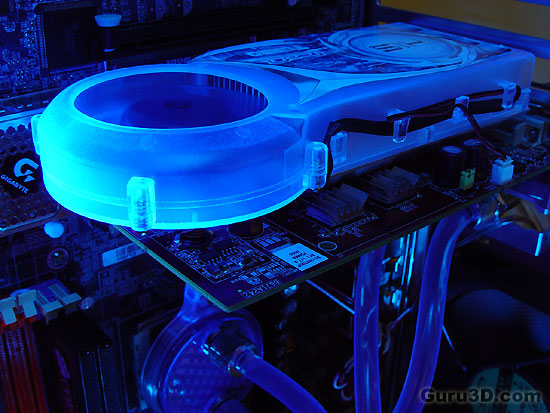Page 4
The need for power - Watt Did You Say?![]()
What we always do with new graphics' cards, we measure the wattage peak with the help of a wattage meter. Slight side note, you are looking at the overall usage of the entire PC. The meter is placed between the power connector and the PSU. So please understand that using a Wattage meter is not the most reliable way of measuring power consumption. You basically look at how much power is the power circuit from your house pulling from the PSU. So you need to look at the results as being an indication and not an exact science.
Let's have a look at some X1000 products in regards to total PC power consumption:
|
||||||||||||||||||||||||||||||||
I suggest
you need a 300 Watt PSU, better is always recommended especially if you keep SLI in mind as a future upgrade. When you buy a new PSU then look at the packaging and check the 12 volts rail on Ampere, 15 AMPS should be fine.Here are some indications on what would happen if your PSU can't cope with the load:
- unusual fluctuating 3D gaming performance
- crashing games
- spontaneous resetting PC
- freezes during gameplay
- PSU overload can cause it to break down or shut down
So many things can happen, the X1600 Pro even in setup Crossfire however is nowhere in the high ranking of power consumption.
ICEQ cooling - temperatures of the graphics card![]()
It's quite amazing how all IceQ based cards show similar temperatures, and yes, their plastic shell is UV reactive, so spend a few bucks on a blacklight please as that looks fantastic. The outcome is really something else. Look at the photo.

Here we see that UV reactiveness at work, ooh come on, that is cute !
IceQ works fantastically. The cooling system uses the air inside your PC case and exhausts warm air outside the case. This is a huge plus as videocards these days can get quite hot. With normal cooling, heat will warm up the ambient temperature of your PC's interior and cascade the effect by warming up other components. The IceQ technology helps prevent this as that heat is exhausted outside the PC. Also part of IceQ technology is cooling the cards memory.
Based on the graphics core temperature the fan will rotate either faster or slower (RPM) to maintain acceptable noise levels, but to be honest, even when it's at 100% the noise is hardly noticeable.
HiS states that this cooling will bring you an 11°C temperature drop when compared to the reference cooling solution. I dare to state it's even better then 11 Degrees C as neither card peaked above 51 Degrees C. |
||
Roughly 50 Degrees C when it's peaking .. that's practically nothing.
Noise Levels coming from the graphics card ![]()
When graphics cards produce a lot of heat usually that heat needs to be transported away from the hot core as fast as possible. Often you'll see massive active fan solutions that can indeed get rid of the heat, yet all the fans these days make the PC a noisy son of a gun. I'm doing a little try out today with noise monitoring, so basically the test we do is extremely subjective. We bough a certified dBA meter and will start measuring how many dBA originate from the PC. Why is this subjective you ask? Well, there is always noise in the background, from the streets, from the HD, PSU fan etc etc, so this is by a mile or two not a precise measurement. You could only achieve objective measurement in a sound test chamber.
The human hearing system has different sensitivities at different frequencies. This means that the perception of noise is not at all equal at every frequency. Noise with significant measured levels (in dB) at high or low frequencies will not be as annoying as it would be when its energy is concentrated in the middle frequencies. In other words, the measured noise levels in dB will not reflect the actual human perception of the loudness of the noise. That's why we measure the dBa level. A specific circuit is added to the sound level meter to correct its reading in regard to this concept. This reading is the noise level in dBA. The letter A is added to indicate the correction that was made in the measurement.
|
| ||||||
Construction Site
110 dBA
Intolerable
Shout (5 feet)
100 dBA
Heavy truck (50 feet)
90 dBA
Very noisy
Urban street
80 dBA
Automobile interior
70 dBA
Noisy
Normal conversation (3 feet)
60 dBA
Office, classroom
50 dBA
Moderate
Living room
40 dBA
Bedroom at night
30 dBA
Quiet
Broadcast studio
20 dBA
Rustling leaves
10 dBA
Barely audible
We startup a benchmark, we take the dBA meter, move away 75 CM and then aim the device at the active fan on the graphics card.
We measure roughly 41 dBa on the PC, which is to be considered a quiet noise level coming from the PC. I'm slowly getting more and more dissatisfied about this reference cooler as I think it's too loud. Again, this is a very subjective test.
